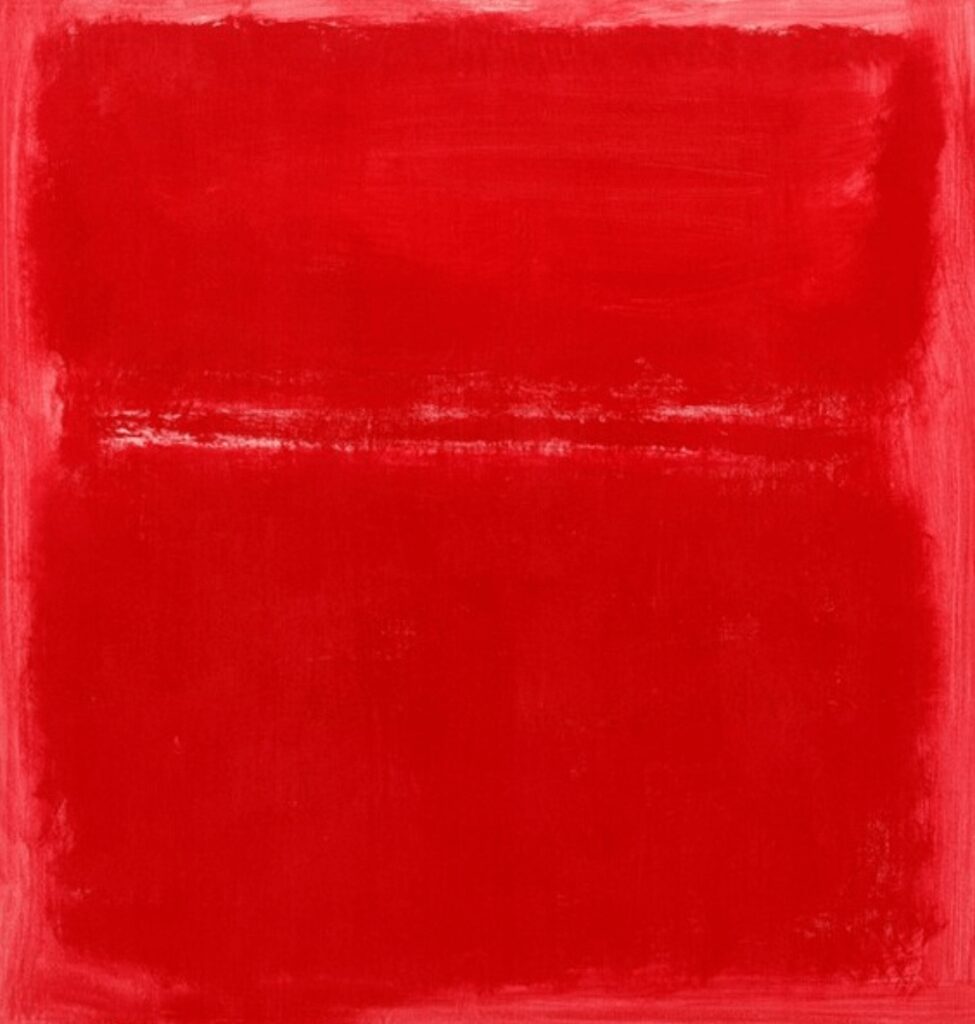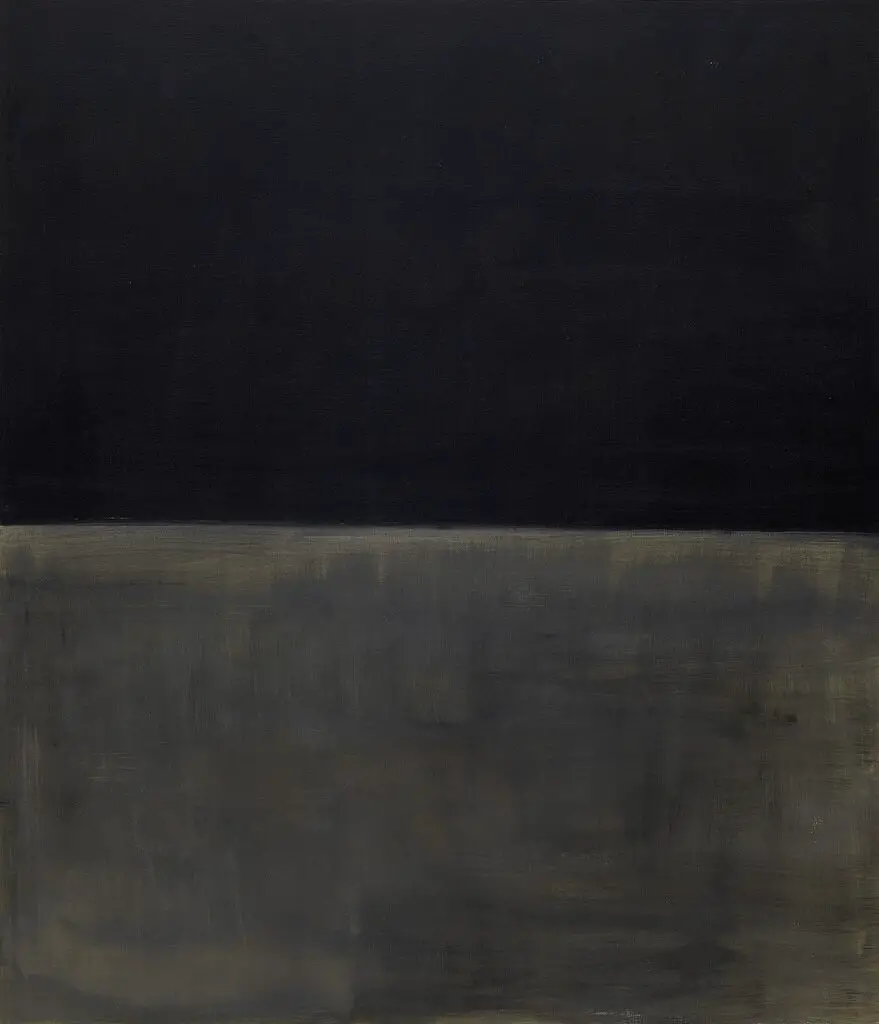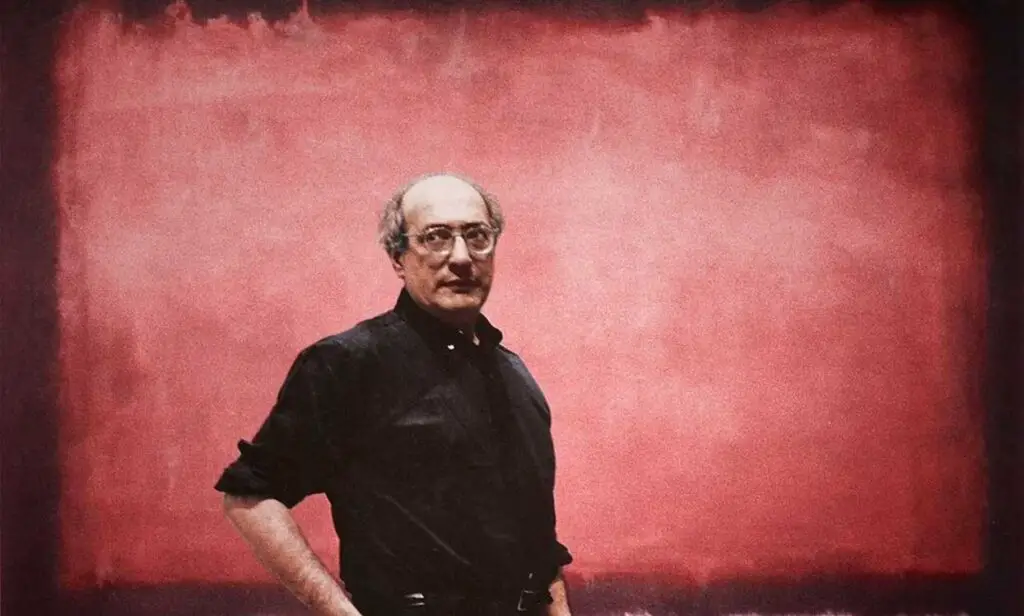Mark Rothko was one of the most important painters in the 20th century. But like many great painters, he died in a tragic matter by suicide in 1970.
His final painting, a bright red painting called Untitled, 1970 many feel symbolizes blood, particularly his blood as he died from an overdose and slashed his wrists; Mark Rothko was 66 years old and left no suicide note. Before his death, we know that he also painted a black and grey series that many have felt was his painted suicide note.
Table of Contents
- Untitled 1970, By Mark Rothko – His Last Painting
- Black On Grays Paintings – By Mark Rothko (Untitled, 1970)
- 15 Enlightening Facts About Mark Rothko: The Luminary of Abstract Expressionism
- Frequently Asked Questions
- Related Questions
Untitled 1970, By Mark Rothko – His Last Painting

The final painting by Mark Rothko is titled “Untitled 1970.” Though this painting is very similar to many others, there are also some differences.
One of the first things you will notice about this iconic painting is that the painting is almost all red with some white. Even though it has his trademark rectangles, the painting is just one color, red.
Many feel this painting was painted red and a different color from many of his other paintings, which have more subdued colors and are not as bright a red as the red used in Untitled 1970/ We do not know for sure – still, many feel it was Mark Rotho symbolizing blood – in particular his blood.
Mark Rothko’s Suicide – 25 February 1970
In February 1970, on a cold winter morning, the body of Mark Rothko was found in his Manhattan studio. He had overdosed on barbiturates and cut an artery on his right arm with a razor blade.
He was found in a pool of blood six feet by eight feet wide, wearing longjohns and thick black socks. He left no note; he was only 66 years old.
No one knows why he committed suicide. Even his children do not understand why. In speaking to the Guardian, his daughter Kate Rothko Prizel said this about her father’s death:
‘”No one would deny that my father was very depressed towards the end of his life. I used to be very engrossed with that idea, too. There was a terrible tendency for me to see the paintings darkening, becoming less accessible emotionally, more hard-edged. I had a hard time separating them from his depression. But then I saw an exhibition at the Menil Collection in Houston, work that followed his completion of the paintings for the Rothko Chapel [commissioned by Dominique and Jean de Menil in the mid-1960s]. I hadn’t been familiar with those works. It was a period when I wasn’t in the studio a lot, and my father didn’t have any at home. It was fascinating to see how those works had grown out of the chapel, and then how they led to the black and greys. That was the beginning of a whole new way of seeing for me.”
Kate Rothko Prizel
Mark Rothko left no will, and his estate and paintings ended in a lengthy legal battle that eventually, his daughter Kate, who was 19 years old when he died, and son Christopher, who was six years old, won; his paintings and estate ended up in a lengthy legal battle for over ten years.
Shortly before his death, Rothko and his financial advisor, Bernard Reis, had created a foundation to fund research and education; the foundation was to receive the bulk of Rothko’s estate.
But upon Rothko’s death, Reis sold the paintings to the Marlborough Gallery at a much-reduced price; Bernard Reis split the profits with the Marlborough gallery owners.
Just six months after his untimely death, his second wife and mother of his two children also died. His daughter, then 19 years old, started the legal proceedings to get back her father’s estate.
When Mark Rothko died, there were still 798 paintings that were not sold, and even in the 1970s, dollars were estimated to be valued in the millions. His children and what should have been his rightful heirs eventually won the case and got control of his estate, but not before many of his paintings were sold.
In 1968, Mark Rothko suffered an aortic aneurysm; during his recovery, he was limited in how he could paint. He started to paint some of the black-on-grey series. We are unsure if this is a prelude to his death, but the paintings are more depressive than his previous work.
Black On Grays Paintings – By Mark Rothko (Untitled, 1970)

Many feel that Mark Rothko’s painting series, known as black on Grays, was his kind of suicide note. The work is black and almost oppressive compared to his earlier paintings.
There is soberness about these paintings that you can see when compared to many of his other paintings, which have a brighter feel.
The paintings are black rectangles and gray rectangles. There’s a buildup of thin translucent layers of shaded black; the effect is strangely ambiguous.
Mark Rothko was known to say that the Black and Grey paintings were about death. He painted them as lonely and empty images.; one of his most famous ones is the Untitled 1970 of the Black and Grey series.
The black and grey series was not his final painting, as his final painting is also Untitled 1970, but with the red blood color, yet the black and gray painting shows a sense of doom and death.
The black and grey paintings were a prelude to Mark Rothko’s death. The English Newspaper The Guardian wrote this about their conversations with his daughter Kate Rothko Prizel and her father’s later work:
“She (Kate) would like people to see the late work as just that – late work – and to relish it for its own sake, the way we might the distinctive late bloom of any other artist, rather than regard it as a symptom of the dark clouds overhead. ‘Even I have to step back from the biography at times,’ she says. ‘From my father as I knew him. Because, sometimes, that leads to misinterpretation.’
The Guardian
For me, the late paintings stand, as much as anything, as a corrective to the earlier work, with its warming yellows and pinks. They remind you that what Rothko most feared and disdained – the idea that his work was regarded as decorative – is too narrow, or at least too easy, a way of seeing him.”
Nobody knows whether or not his last painting, Untitled 1970 with its bright red colors, was signifying blood and was a prelude to his eventual suicide. We also do not know if the black and gray was a prelude to the depression he was having and if it was his painted suicide note to let us all know how much he was suffering.
Even his family is unsure of these facts because he left no note to tell us precisely what he was thinking.
We know that he was and continues to be one of the most valuable and essential artists that ever lived in the 20th century. Even today, his paintings continue to fetch record prices at auctions worldwide.

15 Enlightening Facts About Mark Rothko: The Luminary of Abstract Expressionism
Mark Rothko, a titan in the 20th-century art world, captivated audiences with his profound and dynamic paintings. His revolutionary approach to art and color has cemented his position as a pivotal figure in Abstract Expressionism.
Dive into these 15 illuminating facts about the artist and discover what made Rothko truly exceptional.
Latvian Origins:
Born Markus Yakovlevich Rothkowitz in 1903, Rothko emigrated from Dvinsk, Latvia (then part of the Russian Empire) to Portland, Oregon, with his family at age 10.
Educational Pursuits:
Initially, Rothko attended Yale University to become a labor leader and an engineer. However, his true calling in art soon took precedence.
The Multiforms:
Rothko experimented with surrealistic forms before his signature style emerged. His transition to what he called “multiforms”—large rectangles of color—paved the way for his iconic later works.
Color Field Painting:
Rothko is heralded as a leader in the Color Field movement, a subset of Abstract Expressionism characterized by large swaths of color meant to envelop and captivate the viewer.
Philosophical Depth:
Rothko believed that art was a profound form of communication. He said, “I’m interested only in expressing basic human emotions — tragedy, ecstasy, doom, and so on.”
Chapel Commission:
One of Rothko’s most significant works in his later years was the commissioning of the Rothko Chapel in Houston, Texas. The Chapel showcases 14 of his dark, sad, yet profound murals.
Emotional Experience:
Rothko desired a deep connection between his artworks and viewers. He often recommended viewing his large-scale paintings from a close distance to be enveloped by the experience.
Innovative Technique:
Rothko’s method often involved applying thin layers of paint and letting each layer dry before applying the next, creating a luminous and depth-filled result.
Constant Evolution:
Throughout his career, Rothko’s style evolved from early figurative works to transitional mythological content, culminating in his iconic abstract compositions.
Influences:
Rothko was deeply influenced by Nietzsche’s idea that a person could achieve a transcendent state through art and the works of the ancient Greeks, Freud, and Jung.
Artistic Solidarity:
Along with fellow artists Adolph Gottlieb and Barnett Newman, Rothko wrote an open letter in The New York Times, championing an art free from historical references or specific symbolism.
Against Commercialization:
Rothko was wary of the commercial art world. When he discovered that his Seagram murals might be displayed in a luxury dining setting, he returned the payment and withdrew from the project.
Mysticism:
He believed in the transcendental experience of art. Rothko’s paintings weren’t just visuals but gateways to other realms, providing both the artist and viewer with a spiritual experience.
Legacy:
Despite facing personal challenges and tragically taking his own life in 1970, Rothko left behind a powerful legacy. His works continue to command high prices, with “Orange, Red, Yellow” selling for $86.9 million in 2012.
Inspiration for Future Generations:
Rothko’s bold, vibrant use of color and form has inspired countless artists, validating him as a beacon of innovation in the artistic landscape.

Mark Rothko was more than just an artist; he was a philosopher, a visionary, and a trailblazer. His commitment to expressing raw, unfiltered human emotion has ensured his lasting imprint on the canvas of art history. The depth and emotion in each brushstroke remain a testament to his genius and the timeless allure of Abstract Expressionism.
Anita Louise Art is dedicated to art education, great artists, and inspiring others to find and create their art. We love art that uplifts and inspires. #ArtToMakeYouSmile! #ArtToMakeYouHappy!
If you are interested in seeing any of my art, you can find out more by clicking here. If you are interested in what inspires me and my paintings, you can discover more by clicking here.
We have a free newsletter and would love you to be part of our community; you can subscribe to the newsletter by clicking here. I would be happy to talk to you if you have any questions. You can reach me, Anita, by clicking here.
Subscribe to our Anita Louise Art YouTube Channel with great videos and information by clicking here.
Join us for our podcast “5 Minutes With Art.” Spend just 5 minutes a week with us to discover and learn about great art and artists. You can find out more about our podcast by clicking here.
Frequently Asked Questions
When did Mark Rothko die?4
Mark Rothko died on February 25, 1970.
How did Mark Rothko die?
Mark Rothko died by suicide. He slit his wrists in his New York studio.
What is Mark Rothko’s last painting?
The last painting Mark Rothko completed before his death was titled “Untitled (Black on Gray)”.
When was Mark Rothko’s last painting completed?
Mark Rothko’s last painting was completed in 1970, the same year as his death.
How many paintings did Mark Rothko complete before his death?
It is estimated that Mark Rothko completed around 800 paintings in his lifetime, with his final painting being “Untitled (Black on Gray)”.
Was Mark Rothko depressed before his death?
Yes, Mark Rothko had struggled with depression for much of his life, and it is believed that this contributed to his decision to take his own life.
What is the significance of Mark Rothko’s last painting?
Mark Rothko’s final painting, “Untitled (Black on Gray)”, is seen by many as a reflection of the artist’s own inner turmoil and the darkness he was feeling in his final days
How much is Mark Rothko’s last painting worth?
Mark Rothko’s final painting is estimated to be worth tens of millions of dollars, although it is not currently for sale.
What was Mark Rothko’s style of painting?
Mark Rothko is known for his abstract expressionist style, which is characterized by large, color-blocked canvases that convey emotional depth.
Did Mark Rothko leave a suicide note?
Yes, Mark Rothko left behind a suicide note in which he expressed his deep despair and struggles with his own artistic legacy.
Related Questions
Why Paintings Like Rothko’s No. 6 (Violet, Green, & Red) Are Expensive
Mark Rothko’s No 6 (Violet, Green, and Red – 1951) was sold in 2014 for 140,000.000 Euro or over 184,000,000 USD. A vast amount for any painting. Many of Mark Rothko’s paintings continue to fetch record numbers at auction houses worldwide.
By clicking here, you can learn more by reading Why Paintings Like Rothko’s No. 6 (Violet, Green, & Red) Are Expensive.
What Makes Mark Rothko’s Paintings So Valuable?
Mark Rothko’s paintings have been valuable for many years; they are in high demand and continue to fetch record prices around the globe. At first glance, the paintings may look simple, but upon closer look, they are very complex; they are meant to evoke our emotions and transport us to another realm.
By clicking here, you can discover more by reading What Makes Mark Rothko’s Paintings So Valuable?.
Why Are Mark Rothko’s Paintings Considered Special?
Mark Rothko’s paintings are remarkable because they are original works of art. He is one of the founders of the abstract expressionism movement and color field painting. But more than that, he believed that his spirit lives within the art and that we, the individuals, can view his art can be taken to a different realm.
By clicking here, you can learn more by reading Why Are Mark Rothko’s Paintings Considered Special?.

